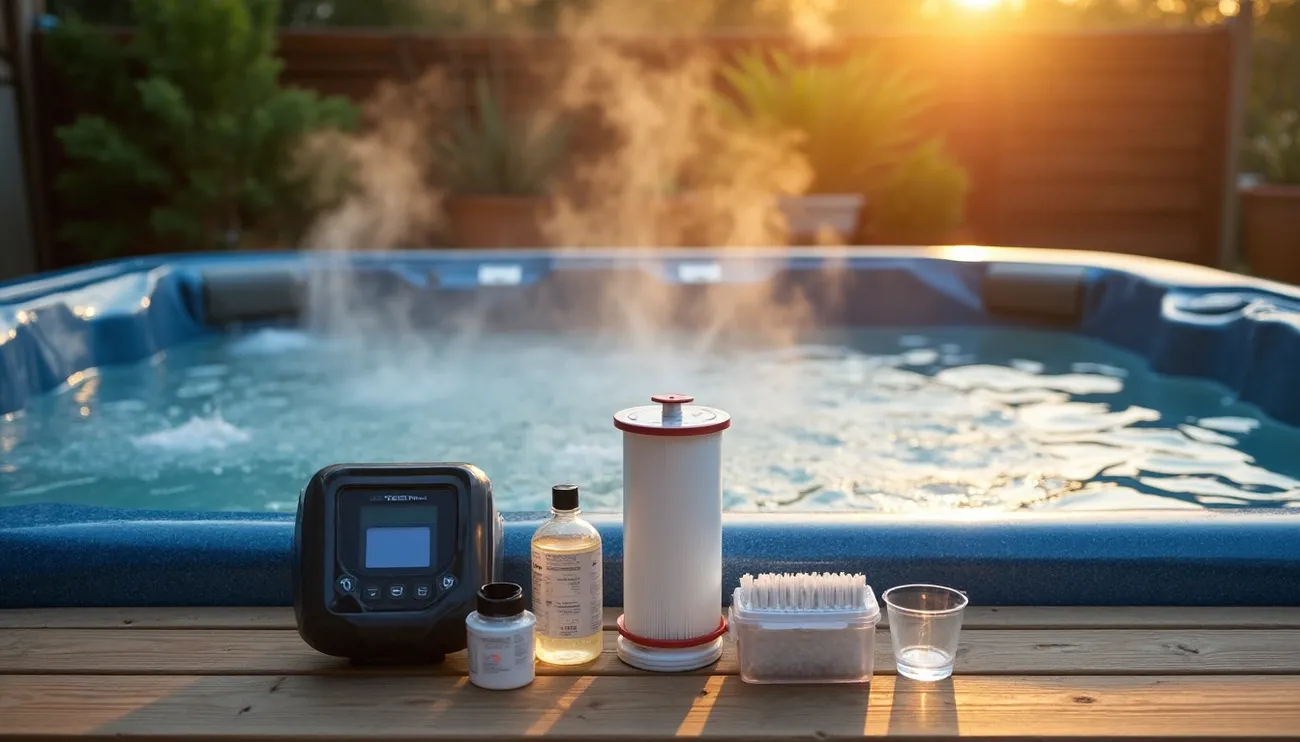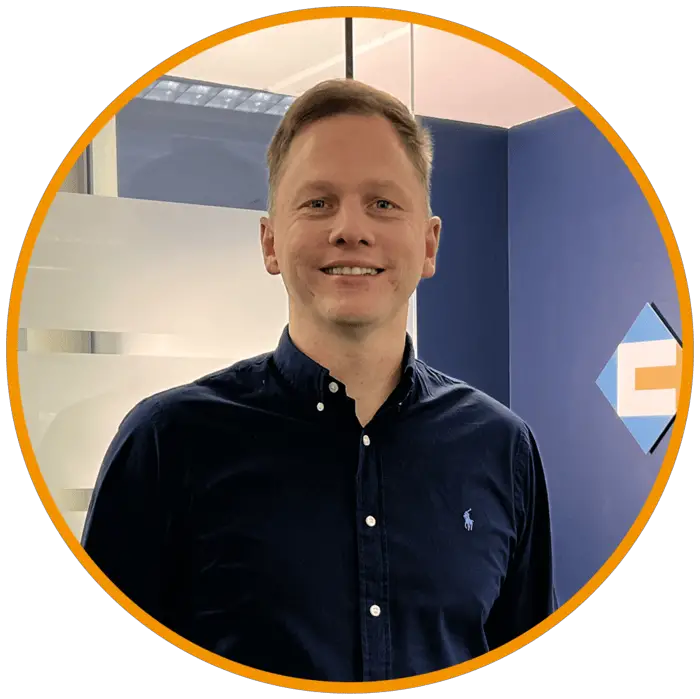Table of Contents - The 2025 Hot Tub Water Maintenance Guide | Tips for Clean, Safe Soaking
- Everything You Need to Know To Keep Your Hot Tub In Great Condition
- Understanding Hot Tub Water Maintenance
- Getting Started: Tools and Supplies You’ll Need
- The 3 Core Rules of Hot Tub Water Maintenance
- How to Balance Hot Tub Water Chemistry
- Filter and Cleaning Schedule for Clear Water
- Salt Water Hot Tub Maintenance Tips
- Final Thoughts
- FAQs
This blog post may contain affiliate links. As an Amazon Associate I earn from qualifying purchases.
One Hot Tub Water Maintenance Guide: Clean, Safe Soaking Made Easy
Everything You Need to Know To Keep Your Hot Tub In Great Condition
Understanding Hot Tub Water Maintenance
Why water care matters
health and safetyextends your spa’s lifespan
Common water issues and what causes them
Cloudy water
- pH or alkalinity throwing a tantrum (aim for 7.2-7.8 pH)
- Sanitizer levels playing hide-and-seek
- Filters begging for a bath
- Lotions and oils from your skin
- Water that’s past its prime
Foaming
- Body lotions and deodorants
- Hair products and makeup
- Leftover detergent hanging out in swimsuits
“chlorine” smellScale depositsBiofilm
How hot tub water differs from pool water
| Factor | Hot Tub | Swimming Pool |
|---|---|---|
| Water volume | Typically 375 gallons | Around 15,000 gallons (38× larger) |
| Temperature | 36-40°C (98-104°F) | 20-30°C (68-86°F) |
| Sanitizer stability | Less stable, depletes faster | More stable, lasts longer |
| Bather load impact | Significant (2 people = high load) | Minimal (2 people = negligible) |
| Water change frequency | Every 3-4 months | Rarely completely drained |
- It keeps working even when things get hot
- It’s kinder to sensitive skin
- It doesn’t have that strong swimming pool smell
Getting Started: Tools and Supplies You’ll Need
Test strips or digital testers
Test stripsDo’s and Don’ts of Water Testing
| Do | Don’t |
|---|---|
| Test water 2-3 times weekly | Test immediately after adding chemicals |
| Follow timing instructions precisely | Touch test pads with wet fingers |
| Store strips in a cool, dry place | Leave test strip bottle open |
| Replace strips annually | Use expired test strips |
Sanitizers: chlorine, bromine, or salt
ChlorineBromineSalt systems
pH and alkalinity balancers
pH increaserspH decreasersAlkalinity increasers
| Feature | Specification |
|---|---|
| Contents | 2 lbs pH Up, 2 lbs pH Down |
| Treatment | Treats up to 10,000 gallons |
| Application | Easy-pour bottles |
| Compatibility | All hot tub types |
Shock treatments and defoamers
Shock treatmentsDefoamers
Filter cleaning tools
- Filter spray cleaner for your weekly quick-clean
- Deep cleaning solution for monthly spa filter spa days
- Filter cleaning wand to dig out debris hiding between pleats
| Item | Purpose |
|---|---|
| Filter Spray | Weekly quick clean |
| Soaking Solution | Monthly deep clean |
| Filter Wand | Removes debris from pleats |
| Filter Bag | Safe storage during cleaning |
spare filter
The 3 Core Rules of Hot Tub Water Maintenance
1. Circulate the water daily
Do’s and Don’ts of Water Circulation
| Do | Don’t |
|---|---|
| Run circulation for 15-30 minutes daily | Let water sit stagnant for days |
| Set automatic cycles if available | Block jets or filter intakes |
| Ensure water level covers filters | Run pumps without filters installed |
| Listen for unusual pump noises | Ignore grinding sounds (sign of problems) |
2. Clean the tub and filters regularly
- Weekly: Give filters a garden hose shower, gently separating pleats to flush out gunk
- Monthly: Treat filters to a spa day with dedicated cleaner, wait 15 minutes, then rinse
- Quarterly: Let filters soak in cleaning solution for 12-24 hours (like a deep-tissue massage for your filter)
| Feature | Specification |
|---|---|
| Size | 1 quart bottle |
| Compatibility | All filter types |
| Treatment | Cleans up to 6 filters |
| Application | Dilute in water for soaking |
3. Balance the water chemistry
total alkalinitypHsanitizer levels
- Chlorine: 2-4 ppm (just enough to clean, not enough to smell like a pool)
- Bromine: 3-5 ppm (perfect for sensitive skin types)
calcium hardness
How to Balance Hot Tub Water Chemistry
Testing pH, alkalinity, and sanitizer levels
Do’s and Don’ts of Hot Tub Water Testing
| Do | Don’t |
|---|---|
| Test before adding chemicals | Test immediately after adding chemicals |
| Use fresh test strips | Use expired strips |
| Store test supplies in cool, dry place | Leave test bottle open |
| Take water sample from elbow depth | Test surface water only |
| Wait full development time | Rush readings |
| Feature | Specification |
|---|---|
| Test parameters | pH, alkalinity, sanitizer |
| Battery | 2 AAA (included) |
| Display | Digital LCD readout |
| Accuracy | Within 0.1 pH units |
Adjusting pH and alkalinity
Choosing the right sanitizer
- Chlorine – The speedy defender! Works fast and costs less, aiming for 1-3 ppm. Great for all water types but might make sensitive skin a bit grumpy.
- Bromine – The hot water hero! Stays strong in high temps and plays nicer with sensitive skin. Keep it between 3-5 ppm for best results.
- Salt Systems – The hands-off helper! Turns salt into chlorine automatically, giving you gentler water with less chemical handling.
| Feature | Specification |
|---|---|
| Duration | 4 months |
| Compatibility | All hot tub types |
| Chemical reduction | Up to 50% |
| Installation | In-line or floating |
When and how to shock your hot tub
- Non-chlorine shock – Perfect for weekly maintenance. It cleans things up without adding sanitizer, and you can hop back in after just 20 minutes!
- Chlorine-based shock – The heavy-duty cleaner. Great after a big hot tub party or when changing water.
Steps for properly shocking your hot tub:
- Test and balance pH (7.2-7.6) and alkalinity (80-120 ppm) first
- Remove hot tub cover
- Turn on jets (but close air valves)
- Measure shock precisely according to manufacturer’s instructions
- Add shock to water near jets for circulation
- Run circulation for at least 20 minutes
- Test water before re-entering
Filter and Cleaning Schedule for Clear Water
Daily, weekly, and monthly filter care
Filter Maintenance Schedule:
| Frequency | Maintenance Task | Time Required |
|---|---|---|
| Weekly | Rinse with garden hose | 5-10 minutes |
| Monthly | Spray with filter cleaner | 15 minutes |
| Quarterly | Deep soak in cleaning solution | 12-24 hours |
Do’s and Don’ts of Filter Care:
| Do | Don’t |
|---|---|
| Have spare filters to rotate | Use pressure washers or power hoses |
| Allow filters to dry completely | Clean with household detergents |
| Check for damage during cleaning | Reinstall wet filters |
| Mark replacement dates on calendar | Use damaged filters |
How to deep clean your hot tub
- Add plumbing cleaner to water and run jets for 20-30 minutes
- Drain the hot tub completely
- Remove and clean filters separately
- Spray shell with specialized cleaner
- Wipe surfaces with non-abrasive cloth
- Clean cover inside and out with appropriate cleaner
- Refill with fresh water
- Balance chemicals before use
When to drain and refill your spa
- Foamy water that laughs at your anti-foam treatments
- Funky smells when you lift the cover
- Cloudy water that refuses to clear up
- Chemistry levels that won’t stay balanced no matter what you do
Inflatable hot tub water maintenance tips
| Feature | Specification |
|---|---|
| Contents | Filter cleaner, surface cleaner, water clarifier |
| Compatibility | All inflatable hot tub brands |
| Treatment cycles | Lasts up to 3 months |
| Application | Simple pour-in formulas |
Salt Water Hot Tub Maintenance Tips
How salt systems work
Salt System Product Recommendation:
| Feature | Specification |
|---|---|
| Capacity | Up to 1,000 gallons |
| Salt level | 2,500-3,000 ppm |
| Cell life | 3-5 years |
| Power | 120V, 60Hz |
Hot springs salt water hot tub maintenance
Do’s and Don’ts of Salt Water Maintenance:
| Do | Don’t |
|---|---|
| Check salt levels monthly | Use table salt or rock salt |
| Clean salt cell quarterly | Run system below 60°F |
| Balance pH and alkalinity regularly | Exceed recommended salt levels |
| Replace cartridges as scheduled | Ignore corrosion warning signs |
Pros and cons of salt water systems
Pros:
- Water feels silky-smooth – like swimming in liquid luxury!
- Fewer chemicals to handle – your storage shelf will thank you
- Gentler on sensitive skin and eyes – bye-bye red eyes!
- Water can last up to 12 months between changes – talk about low maintenance!
- More natural bathing experience – almost like a mineral spring
Cons:
- Costs more upfront ($500-$5000 extra) – ouch for the wallet
- Metal parts might get grumpy (corrosion) – especially with older tubs
- Salt cells need replacement every 3-5 years – like changing your phone
- Gets lazy in cold weather (below 60°F) – don’t we all?
- Still needs regular chemistry checks – no completely free rides here!
Maintenance for salt water hot tub vs. chlorine
Final Thoughts
| Feature | Specification |
|---|---|
| Contents | Test strips, sanitizer, pH balancers, shock treatment |
| Duration | 3-month supply for average use |
| Compatibility | All hot tub types |
| Application | Clear instructions included |
FAQs
Q1. How often should I perform hot tub maintenance?Q2. What are the ideal chemical levels for hot tub water?Q3. How can I prevent foam in my hot tub?Q4. What’s the difference between salt water and traditional chlorine hot tubs?Q5. How do I maintain my inflatable hot tub?




